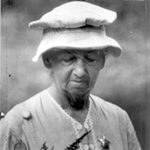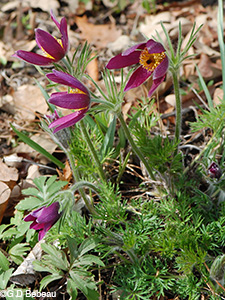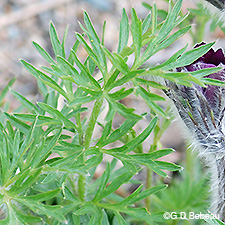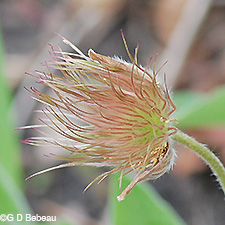
The Writings of Eloise Butler
Pasque Flowers at Easter Time Proclaim Yearly Spring Miracle.
Published in the Minneapolis Sunday Tribune April 16, 1911
[Note: To facilitate identification of plants, we have taken the liberty of adding the information that is within brackets and also all the botanical names have been put into italics. The language of Eloise's day is left as written. Additional notes at the bottom of the page.]

However early Easter Sunday is in the calendar, the bells of the Pasque flower proclaim the yearly miracle. Or, to change the metaphor, nearly four weeks ago, on sandy, southern slopes of the virgin prairie, the “goslings,” as children call them, thrust their downy heads above the brown, bare earth, undismayed by succeeding snows and frosts, all the way from Wisconsin to the Rockies.
In exposed situations they lie huddled on the ground; but, under the stimulus of increasing warmth, they will peep out from the stretch above the brooding mother earth, from day to day, throughout the month of April.
The scientific name of the Pasque flower, according to the seventh edition of Gray’s Botany, is Anemone patens var. wolfgangiana. It is called a variety because the Pasque flower of Europe was first named. None but a botanist would note the difference between the European and American forms. Britton calls the plant Pulsatilla hirsutissima. [Both older names now classified as Anemone patens L. var. multifida Pritz.]
Under this name it is known to pharmacists, for it has medicinal properties. The leaves when bruised exhale a pungent odor, which has given rise to other popular names, as hartshorn and headache plant.
Mrs. Helen Hunt-Jackson, perhaps better known as “H.H.” has thus recorded her first view of this exquisite flower in Bits of Travel at Home:
The first Colorado flower I saw was the great blue wind-flower, or anemone. it was brought to me one morning, late in April, when snow was lying on the ground, and our strange spring-winter seemed to be coming on fiercely. The flower was only half open, and only half way out of a gray, furry sheath some two inches long; it looked like a Maltese kitten’s head, with sharp-pointed blue ears - the daintiest, most wrapped-up little blossom. “A crocus, out in cinchilla fur!” I exclaimed.


“Not a crocus at all; an anemone,” said they who knew.
It is very hard, at first, to believe that these anemones do not belong to the crocus family. They push up through the earth in clusters of conical gray, hairy buds, and open cautiously, an inch or two from the ground, precisely as the crocuses do; but, day by day, inches at a time, the stem pushes up, until you suddenly find, some day, in a spot where you left low clumps of what you will persist, for a time, in calling blue crocuses, great bunches of waving blue flowers, on slender waving stems from six to twelve inches high, the blossoms grown larger and opened wider, until they look like small tulip cups, like the Italian anemones.
A week or two later you will find at the base of these clumps a beautiful mat of leaves, resembling the buttercup leaf, but much more deeply and numerously slashed on the edges. These, too, grow at last, away from the ground and wave in the air; and, by the time they are well up, many of the flowers have gone to seed, and on top of each stem flutters a great ball of fine, feathery seed plumes, of a green or claret color, almost as beautiful as the blossom itself.